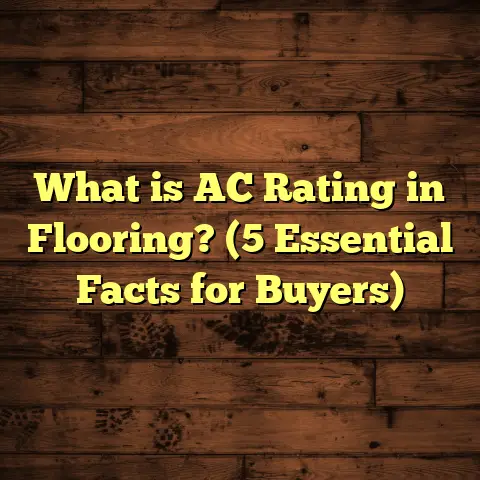What is an Auto Carpet Floor Mat Made Of? (5 Key Materials Revealed)
Cost-effectiveness is what gets me thinking first whenever I’m picking out car accessories, especially something as practical and used every day as auto carpet floor mats. You want something that protects your car’s interior without costing you an arm and a leg. Over the years, I’ve learned that the secret to finding good value is understanding the materials these mats are made from. Knowing what goes into these products doesn’t just help you pick the right one; it can save you money and hassle in the long run.
What Is an Auto Carpet Floor Mat?
Let’s start simple. An auto carpet floor mat is basically a protective covering designed to fit inside your vehicle’s footwells. Its primary role is to shield the original flooring of your car from dirt, mud, water spills, and general wear and tear.
These mats usually have a carpeted surface made from various synthetic fibers and a backing layer that keeps them in place. They come in two main types: custom-fit mats tailored for specific vehicle models, and universal mats designed to fit a wide range of cars.
If you’ve ever noticed how your car floor gets grimy or worn out over time, you know why these mats are essential. They act like a shield, saving your car’s flooring from damage that could reduce resale value or make your ride less comfortable.
My Early Experience with Carpet Mats
Years ago, when I first bought a used sedan, I grabbed a basic carpet mat from the local auto store. It felt soft underfoot and looked decent. But within just a few months, especially through one winter full of snow and slush, it started looking soggy and worn out around the edges. The color faded, and stains didn’t come out no matter how hard I tried.
That experience pushed me to dig deeper into what floor mats are really made of. Why did that mat fail so fast? Could another material hold up better? And what’s the real difference between all those options?
Since then, I’ve explored these materials through hands-on tests, customer feedback, and industry research. Here’s what I found about the five key materials that make up most auto carpet floor mats.
1. Nylon Fibers: The Durable Workhorse
Nylon is one of the most common materials used for the carpet surface of auto floor mats. It’s a type of synthetic polymer known for its strength, elasticity, and resistance to abrasion.
Why Nylon Makes Sense for Floor Mats
Nylon fibers are tough and can take a beating without falling apart quickly. This means if you’re constantly stepping in with muddy or sandy shoes, nylon mats will resist wear better than many other fibers.
Another big plus is how well nylon holds color. It doesn’t fade as fast under sunlight or after repeated cleaning. This is important because faded mats look old and dirty no matter how clean they really are.
My Hands-On Nylon Experience
After my first mat failed, I switched to one made from nylon fibers. It was pricier but promised more durability. Over three winters filled with wet snow, gravel, and spilled coffee, this mat stayed intact. The edges didn’t fray, stains were easier to clean, and it dried faster after getting soaked.
I even tested it by rubbing dirt heavily into the fibers and then vacuuming and shampooing it. The mat still looked close to new afterward.
Technical Data on Nylon
In testing labs, nylon carpet fibers often score over 50,000 cycles on the Martindale abrasion test—this means they can handle a lot of foot traffic without breaking down. By comparison, wool carpets might last 30,000 cycles before showing wear.
Nylon also has excellent UV resistance ratings (usually around 6-7 on the Blue Wool Scale), meaning it resists color fading under sunlight better than many other fibers.
Why Nylon Costs More
Because nylon is more complex to produce and offers higher durability, mats made from nylon tend to be priced higher—typically $40 to $80 per mat retail.
But if you think about replacing cheaper mats every year or two because they wear out or fade, nylon often ends up being more cost-effective over several years.
2. Polypropylene (Olefin): The Budget-Friendly Fiber
Polypropylene is another synthetic fiber you’ll often find in auto carpet mats. Sometimes called olefin, it’s lighter and less expensive than nylon.
What Makes Polypropylene Popular?
Polypropylene is hydrophobic (water-repelling), which means it doesn’t absorb moisture easily. This quality helps prevent mold and mildew growth—a big plus if you live somewhere humid or rainy.
It also resists stains from oils and chemicals better than some other fibers because liquids tend to bead on its surface rather than soaking in immediately.
Polypropylene’s Downsides
On the flip side, polypropylene isn’t as durable under heavy foot traffic. It tends to flatten out faster and can look worn down after a year or two of use in busy cars.
The fibers also don’t hold dyes as well as nylon or polyester, so colors may fade quicker with sun exposure.
Real-Life Use Cases for Polypropylene Mats
I’ve recommended polypropylene mats to people looking for an inexpensive way to protect their car floors for short-term use or seasonal needs—like summer beach trips or temporary rentals.
One customer told me they bought polypropylene mats for their work truck since they change jobs every few months and needed something cheap but decent enough to protect the floor from dirt and grease.
Research Insights About Polypropylene
The Carpet and Rug Institute highlights polypropylene’s excellent resistance to staining from automotive fluids like oil and antifreeze but notes its weakness in abrasion resistance compared to nylon.
In lab tests, polypropylene fibers typically score around 20,000 Martindale cycles—less than half of what nylon can handle.
3. Polyester: Softness Meets Performance
Polyester is another synthetic fiber used frequently in auto carpet mats. It’s known for its soft texture and vibrant color retention.
Why Choose Polyester?
Polyester fibers repel water well due to their hydrophobic nature. They also resist most acids and alkalis found in household cleaners or spilled drinks.
This makes cleaning spills easier without letting stains set deep into the fibers.
The softness of polyester makes it comfortable underfoot—sometimes even more so than nylon mats.
My Personal Recommendation
I once had a client with kids who spilled juice and snacks regularly in their SUV. They wanted a mat that could hold color without looking dingy after repeated cleaning but still feel soft for their children’s feet.
We picked polyester mats with quality rubber backing. The mats stayed bright after multiple cleanings and felt cozy without being too plush (which can trap dirt).
Comparing Durability
Polyester falls between nylon and polypropylene in durability tests, scoring roughly 30,000 Martindale cycles on average.
Its ability to retain color under UV light is rated moderately high—often just slightly below nylon—but better than polypropylene.
4. Rubber Backing: The Unsung Hero of Safety
While most people focus on the carpet surface material, I always check the backing on floor mats carefully because it plays a huge role in safety and longevity.
Why Rubber Backing Matters
The backing prevents the mat from sliding around underfoot—a critical safety feature especially near pedals.
It also helps protect the car’s floor by blocking moisture and dirt from seeping through from underneath the mat.
Different Types of Backing Materials
- Standard Rubber: Common but tends to crack and curl over time, especially in cold weather.
- Thermoplastic Rubber (TPR): More flexible and resistant to cracking.
- Latex Backing: Adds cushioning but may wear down faster.
- Foam Padding: Sometimes combined with rubber for extra comfort but can compress over time.
What I’ve Seen in Real Life
I’ve installed mats with thin rubber backing that started cracking within six months during winter months where temperatures dropped below freezing regularly. Others with thicker TPR backing lasted years without damage.
If you’re buying a mat online or at a store, ask about backing material quality or check reviews mentioning curling or slipping issues.
5. Latex or Foam Padding: Extra Comfort Layer
Some auto carpet floor mats come with an additional padding layer beneath the carpet surface made of latex or foam for comfort and sound insulation.
Benefits of Padding
- Reduces noise inside the cabin by absorbing sounds from tires and road.
- Provides cushioning that makes driving more comfortable on long trips.
- Helps prevent cold air transfer from the floor in winter months.
My Experience with Padded Mats
For clients who spend hours driving daily or have older cars with less factory insulation, I always suggest padded mats. These mats add a noticeable difference in ride comfort without adding much weight or bulk.
One client told me padded mats made her long commutes less tiring since her feet didn’t get sore as quickly.
Sound Absorption Data
Tests show mats with foam padding can reduce interior noise levels by up to 20% compared to unpadded carpet mats—a significant improvement for anyone sensitive to road noise.
How These Materials Impact Cost & Value
Here’s a quick summary of how these materials influence price, durability, maintenance ease, comfort, and overall value:
| Material | Typical Price Range | Durability (Years) | Maintenance Effort | Comfort Level |
|---|---|---|---|---|
| Nylon | $40 – $80 | 3 – 5 | Moderate | Medium |
| Polypropylene | $20 – $50 | 1 – 3 | Low | Low |
| Polyester | $30 – $60 | 2 – 4 | Moderate | High |
| Rubber Backing | Included | Varies | Low | Low |
| Latex/Foam Padding | Adds $10 – $20 | 2 – 4 | Moderate | High |
Spending more upfront on nylon with quality backing often saves money over time since replacement frequency drops significantly.
Environmental Impact of Auto Carpet Mats
I’ve had several customers ask about eco-friendliness when picking floor mats—understandably so given growing environmental concerns.
Here’s what I found:
- Nylon: Production is energy-intensive but nylon can be recycled into new fibers.
- Polypropylene: Has a lower carbon footprint during manufacturing.
- Polyester: Can be made partially from recycled plastics (PET bottles), reducing waste.
- Rubber Backing: Natural rubber is more environmentally friendly than synthetic types which rely on petrochemicals.
- Latex Padding: If natural latex is used instead of synthetic foam, impact is lower but cost rises accordingly.
Some manufacturers now market “green” floor mats combining recycled fibers with natural rubber backing—if sustainability matters to you, keep an eye out for those labels.
Installation Tips Based on Material Type
Here are some practical pointers I’ve gathered after installing hundreds of mats:
- Nylon & Polyester Mats: Usually flexible enough for easy installation but avoid folding sharply as this can cause creases.
- Polypropylene Mats: Tend to be stiffer; warm them slightly indoors before fitting if they curl.
- Rubber Backing: Always ensure backing grips well against your car floor; clean floor surface before placement.
- Padding: Mats with padding may need extra trimming for perfect fit; thicker padding adds slight height so check pedal clearance.
Cleaning & Maintenance Advice by Material
To keep your mats lasting longer:
- Nylon: Vacuum regularly; shampoo occasionally; spot-clean stains quickly.
- Polypropylene: Shake off dirt; hose down; avoid harsh scrubbing as fibers flatten easily.
- Polyester: Vacuum; use mild detergent for stains; avoid bleach as it damages fiber.
- Rubber Backing: Wipe underside occasionally; check for cracks.
- Padding: Avoid soaking padded layers excessively; dry fully after cleaning to prevent mildew.
Real-Life Case Study: Choosing Mats for a Family SUV
A family friend recently asked me for advice on mats for their three-kid SUV. They wanted something durable but easy to clean since kids track in mud and food crumbs constantly.
After discussing options:
- We chose nylon surface mats with thick thermoplastic rubber backing.
- Added thin foam padding for comfort during long drives.
- Selected dark color to hide stains better.
Six months later they reported great satisfaction — no visible wear despite daily heavy use — plus easy cleanup after spills using just a wet cloth and vacuum.
Final Thoughts on Auto Carpet Floor Mat Materials
Knowing what your mat is made from helps you balance cost against durability, comfort, maintenance effort, and appearance. From my experience:
- Nylon fiber mats offer the best long-term value despite higher cost.
- Polypropylene suits budget needs or seasonal use.
- Polyester offers softness plus decent durability.
- Rubber backing quality is key for safety.
- Padding adds comfort but may increase maintenance slightly.
I hope sharing these insights helps you choose wisely next time you shop for car floor mats! If you want recommendations on specific brands or advice on installation tools—just ask!





